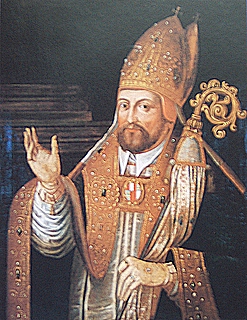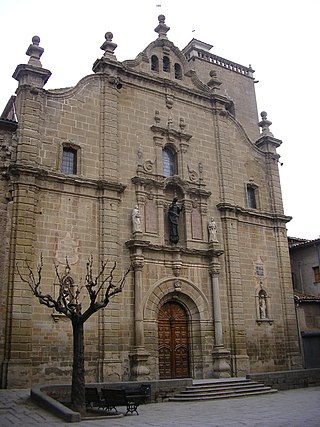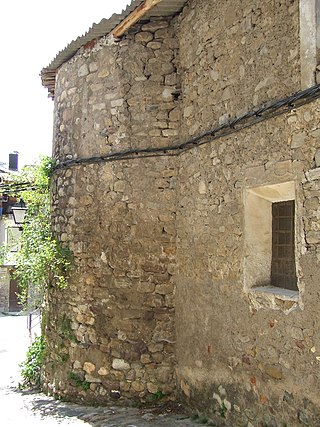Related Research Articles
Andorra, officially the Principality of Andorra, also called the Principality of the Valleys of Andorra, is a sovereign landlocked microstate in Southwestern Europe, located in the eastern Pyrenees mountains and bordered by Spain and France.

A prince-bishop is a bishop who is also the civil ruler of some secular principality and sovereignty, as opposed to Prince of the Church itself, a title associated with cardinals. Since 1951, the sole extant prince-bishop has been the Bishop of Urgell, Catalonia, who has remained ex officio one of two co-princes of Andorra, along with the French president.

La Seu d'Urgell is a town located in the Catalan Pyrenees in Spain. La Seu d'Urgell is also the capital of the comarca Alt Urgell, head of the judicial district of la Seu d'Urgell and the seat of Bishop of Urgell, one of the Andorra co-princes. It is in the district of Alt Pirineu i Aran, and is the town with the most inhabitants, having 17.4% of the district population. La Seu d'Urgell and Puigcerdà together have 30% of the population of the area.

The County of Urgell is one of the historical Catalan counties, bordering on the counties of Pallars and Cerdanya.

Joan-Enric Vives i Sicília is a Spanish cleric, who has served as Bishop of Urgell since 2003, and is therefore the Co-Prince of Andorra. This makes him a joint-head-of-state and one of the two Catholic religious figures in the world who also leads a country, the other such prelate being the Pope himself.

The Diocese of Urgell is a diocese in Catalonia (Spain) and Andorra in the historical County of Urgell, with origins in the fifth century AD or possibly earlier. It is based in the region of the historical Catalan County of Urgell, though it has different borders. The seat and Cathedral of the bishop are situated in la Seu d'Urgell town. The state of Andorra is a part of this diocese.

Josep Caixal i Estradé (1803–1879) was Bishop of Urgell from 1853 until his death in Rome in 1879 and co-prince of Andorra during the New Reform period.

The co-princes of Andorra are jointly the heads of state of the Principality of Andorra, a landlocked microstate lying in the Pyrenees between France and Spain. Founded in 1278 by means of a treaty between the Bishop of Urgell and the Count of Foix, this unique diarchical arrangement has persisted through medieval times to the 21st century. Currently, the Bishop of Urgell and the president of France serve as Andorra's co-princes, following the transfer of the count of Foix's claims to the Crown of France and, thence, to the president of France. Each co-prince appoints a personal representative, the episcopal co-prince by Josep Maria Mauri and the French co-prince currently being represented by Patrick Strzoda.

Wifred or Wilfred was the Count of Cerdanya and Count of Berga. He was the eldest son of Oliba Cabreta and Ermengard of Empúries.

Saint Ermengol or Hermengaudius was the bishop of Urgell from 1010.
Felix was a Christian bishop and theologian. He served as the bishop of Urgell (783–99) and advocated the christology known as Spanish Adoptionism because it originated in the lands of the former Visigothic Kingdom in Spain. He was condemned for heresy and all his writings were suppressed. They are known today only through quotations contained in the writings of his opponents.

La Seu d'Urgell Cathedral, otherwise Urgel Cathedral of the Cathedral of Santa Maria d'Urgell, is a Roman Catholic cathedral located in the city of la Seu d'Urgell in Catalonia. It is the seat of the Bishops of Urgell, who are also Co-Princes of Andorra. The cathedral is considered unique within Catalan Romanesque architecture for the Italianate-style features on the ornaments of its west front.
Sal·la was the Bishop of Urgell from 981 to 1010, and "one of the first Catalan figures whose own words" survive sufficiently "to give colour to his personality and actions", although all of the words attributed to him were written down by scribes. He receives mention in some sixty-three surviving contemporary documents. As bishop, Sal·la dated documents by the reign of Hugh the Great. Although his episcopate largely preceded the Peace of God movement in Catalonia, his excommunication of high-ranking public figures during a church–state dispute in 991 anticipated it. He also pioneered feudal practices such as the granting of fiefs and was frequently "ahead of the feudalising wave".

Guissona is a town and municipality located in the north of the comarca (county) of Segarra, in the province of Lleida, Catalonia, Spain. With 6,862 inhabitants Guissona is the principal municipality in the northern half of Segarra and the second most populated in the county after Cervera. In addition to the populated place of Guissona, the municipality integrates the smaller place of Guarda-si-venes. The municipality is split into two parts, the bigger eastern part containing almost all the population.

Pedro Folc de Cardona, an illegitimate son of Joan Ramon Folc de Cardona y de Prades, 3rd Count of Cardona, was bishop of Urgell (1472–1515), president of the Generalitat of Catalonia (1482–85), editor of the Usatges de Barcelona (1505), viceroy of Catalonia (1521–23) and archbishop of Tarragona (1515–30).
Wilfred or Wifred, called the Hairy, was Count of Urgell, Cerdanya, Barcelona, Girona, Besalú and Ausona. On his death in 897, his son, Wilfred Borrell, inherited these Catalan counties.
Pere d'Urtx was Bishop of Urgell from 1269 to 1293. He became the first Episcopal Co-Prince of Andorra when he signed the paréage establishing joint-sovereignty over the territory with Roger-Bernard III, Count of Foix in 1278.
Dotila or Dottila was the bishop of Urgell between 765 and his death in 781.
Ingobert was a bishop of Urgell and co-Prince of Andorra.

Posidonius was the bishop of Urgell in northern Spain between 814 and 823. He may have become bishop as early 803, the last year when Archbishop Leidrad was still clearly in control of the diocese following the ouster of Bishop Felix for heresy.